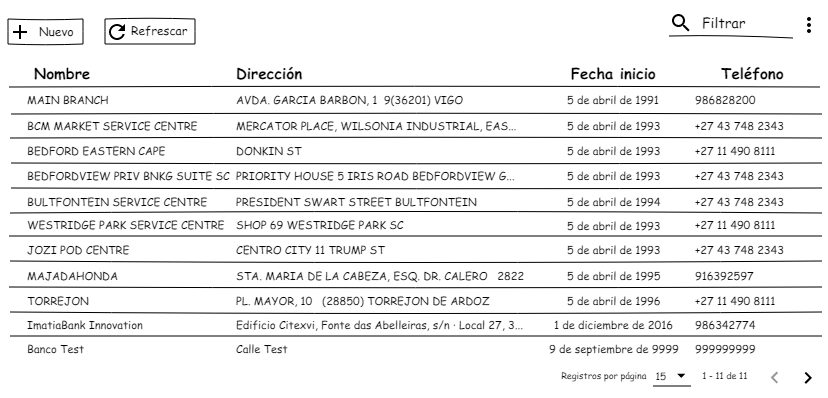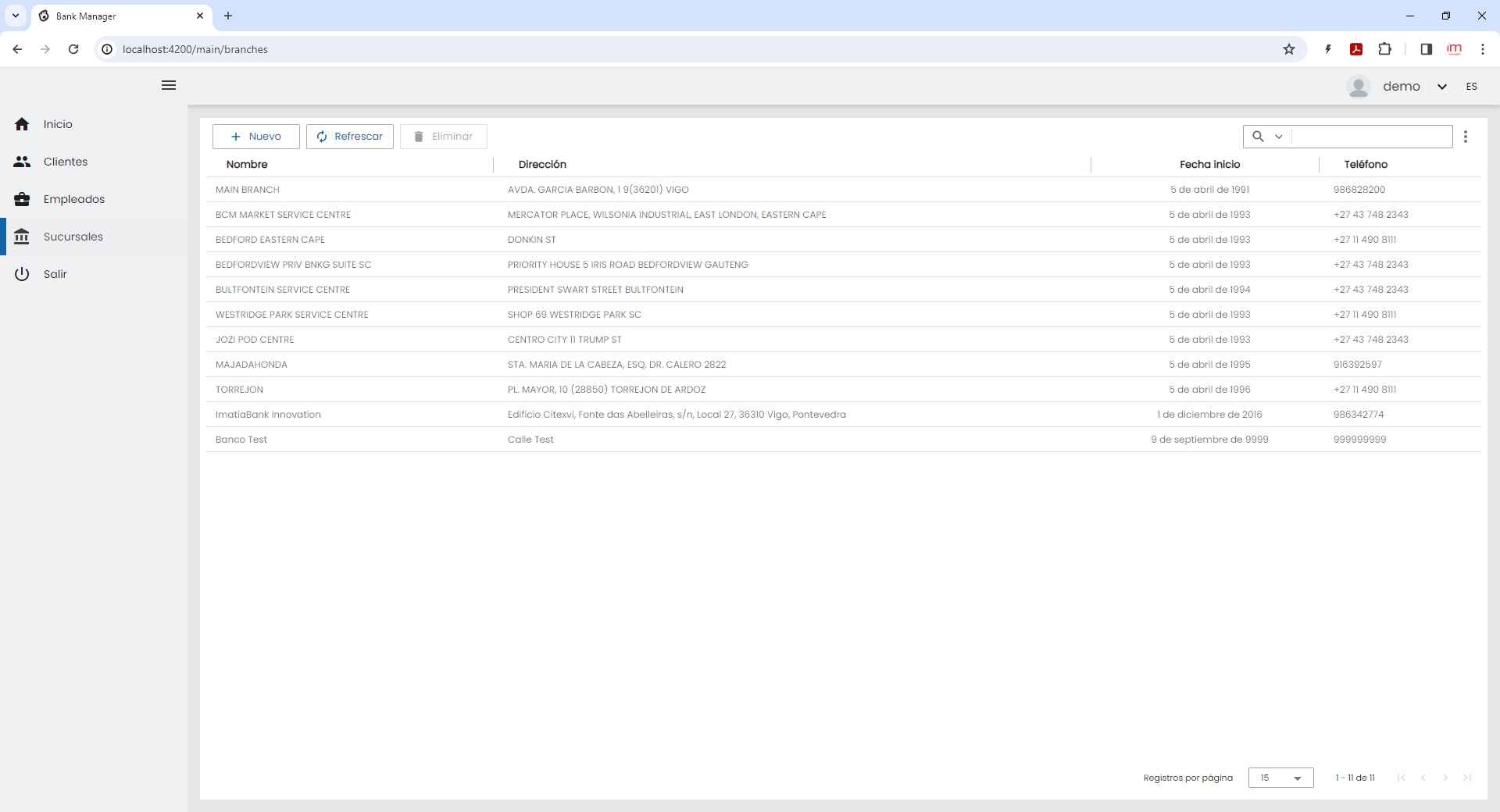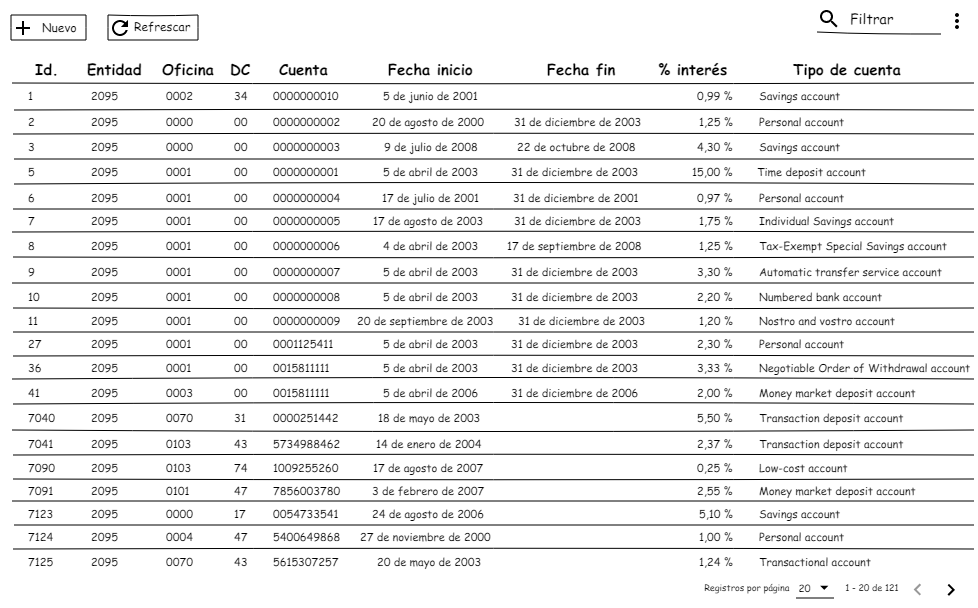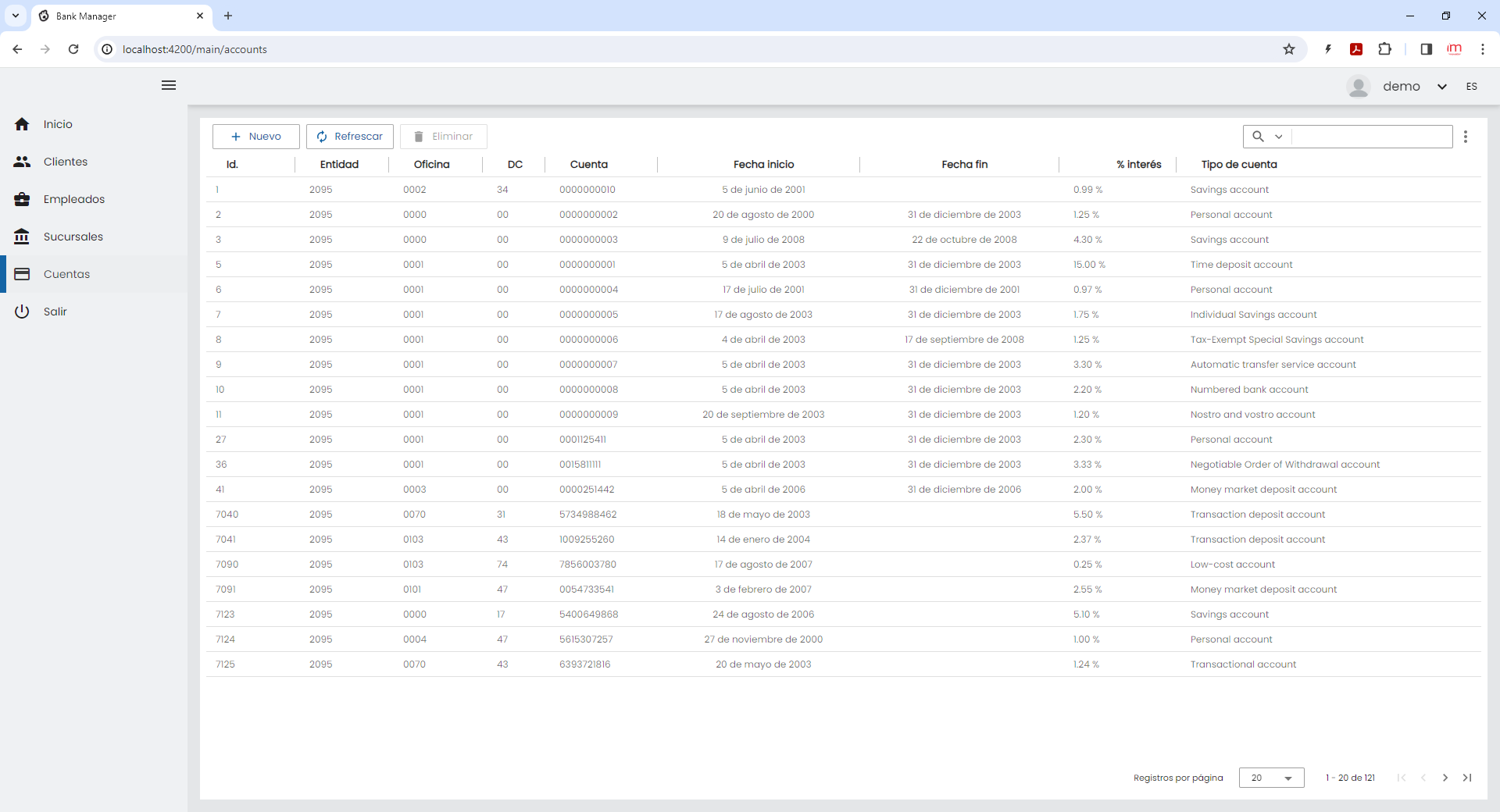Crear formularios de sucursales y cuentas
Sucursales
Crear el módulo de sucursales
Nos situamos dentro de la carpeta main, ejecutamos el comando para crear el módulo de sucursales y modificamos los ficheros para declarar este módulo dentro de la aplicación:
npx ng g module --routing branches
branches.module.ts
import { NgModule } from '@angular/core';
import { CommonModule } from '@angular/common';
import { OntimizeWebModule } from 'ontimize-web-ngx';
import { BranchesRoutingModule } from './branches-routing.module';
@NgModule({
declarations: [],
imports: [
CommonModule,
OntimizeWebModule,
BranchesRoutingModule
]
})
export class BranchesModule { }main-routing.module.ts
import { NgModule } from '@angular/core';
import { RouterModule, Routes } from '@angular/router';
import { AuthGuardService } from 'ontimize-web-ngx';
import { MainComponent } from './main.component';
export const routes: Routes = [
{
path: '',
component: MainComponent,
canActivate: [AuthGuardService],
children: [
{ path: '', redirectTo: 'home', pathMatch: 'full' },
{ path: 'home', loadChildren: () => import('./home/home.module').then(m => m.HomeModule) },
{ path: 'customers', loadChildren: () => import('./customers/customers.module').then(m => m.CustomersModule) },
{ path: 'employees', loadChildren: () => import('./employees/employees.module').then(m => m.EmployeesModule) },
{ path: 'branches', loadChildren: () => import('./branches/branches.module').then(m => m.BranchesModule) }
]
}
];
@NgModule({
imports: [RouterModule.forChild(routes)],
exports: [RouterModule]
})
export class MainRoutingModule { }- bankmanager-web
- e2e
- src
- app.e2e-spec.ts
- app.po.ts
- protractor.conf.js
- tsconfig.json
- src
- src
- app
- login
- login-routing.module.ts
- login.component.html
- login.component.scss
- login.component.ts
- login.module.ts
- login.theme.scss
- main
- branches
- branches-routing.module.ts
- branches.module.ts
- customers
- customers-detail
- customers-detail.component.css
- customers-detail.component.html
- customers-detail.component.ts
- customers-home
- customers-home.component.css
- customers-home.component.html
- customers-home.component.ts
- customers-new
- customers-new.component.css
- customers-new.component.html
- customers-new.component.ts
- customers-routing.module.ts
- customers.module.ts
- customers-detail
- employees
- employees-detail
- employees-detail.component.css
- employees-detail.component.html
- employees-detail.component.ts
- employees-home
- employees-home.component.css
- employees-home.component.html
- employees-home.component.ts
- employees-routing.module.ts
- employees.module.ts
- employees-detail
- home
- home-routing.module.ts
- home.component.html
- home.component.scss
- home.component.ts
- home.module.ts
- main-routing.module.ts
- main.component.html
- main.component.scss
- main.component.ts
- main.module.ts
- branches
- shared
- app.menu.config.ts
- app.services.config.ts
- shared.module.ts
- app-routing.module.ts
- app.component.html
- app.component.scss
- app.component.spec.ts
- app.component.ts
- app.config.ts
- app.module.ts
- login
- assets
- css
- app.scss
- loader.css
- i18n
- en.json
- es.json
- icons
- ontimize128.png
- ontimize16.png
- ontimize256.png
- ontimize32.png
- ontimize48.png
- ontimize64.png
- ontimize72.png
- ontimize96.png
- images
- login_bg.png
- no-image.png
- ontimize.png
- ontimize_web_log.png
- sidenav-closed.png
- sidenav-opened.png
- user_profile.png
- js
- domchange.js
- keyboard.js
- .gitkeep
- css
- environments
- environment.prod.ts
- environment.ts
- favicon.ico
- index.html
- main.ts
- manifest.webmanifest
- polyfills.ts
- styles.scss
- test.ts
- app
- .browserslistrc
- .editorconfig
- .eslintrc.json
- .gitignore
- angular.json
- karma.conf.js
- ngsw-config.json
- package-lock.json
- package.json
- README.md
- tsconfig.app.json
- tsconfig.json
- tsconfig.spec.json
- e2e
Crear el formulario de sucursales
Una vez definido el módulo de sucursales, definiremos el formulario principal de la sucursal, para replicar el siguiente mockup. Nos situamos dentro de la capeta branches creada en el paso anterior, y ejecutamos el comando:
npx ng g component --skip-tests branches-home

branches-home.component.html
<o-form-layout-manager attr="branchesHome" title="{{'BRANCHES' | oTranslate }}" separator=" " mode="dialog" label-columns="NAME">
<o-table attr="branchesTable" service="branches" entity="branch" keys="OFFICEID"
columns="NAME;ADDRESS;STARTDATE;PHONE;OFFICEID" visible-columns="NAME;ADDRESS;STARTDATE;PHONE" query-rows="15">
<o-table-column attr="STARTDATE" title="STARTDATE" type="date" format="LL"></o-table-column>
</o-table>
</o-form-layout-manager>branches-routing.module.ts
import { NgModule } from '@angular/core';
import { RouterModule, Routes } from '@angular/router';
import { BranchesHomeComponent } from './branches-home/branches-home.component';
const routes: Routes = [{
path: '',
component: BranchesHomeComponent
}];
@NgModule({
imports: [RouterModule.forChild(routes)],
exports: [RouterModule]
})
export class BranchesRoutingModule { }branches.module.ts
import { NgModule } from '@angular/core';
import { CommonModule } from '@angular/common';
import { OntimizeWebModule } from 'ontimize-web-ngx';
import { BranchesRoutingModule } from './branches-routing.module';
import { BranchesHomeComponent } from './branches-home/branches-home.component';
@NgModule({
declarations: [
BranchesHomeComponent
],
imports: [
CommonModule,
OntimizeWebModule,
BranchesRoutingModule
]
})
export class BranchesModule { }app.menu.config.ts
import { MenuRootItem } from 'ontimize-web-ngx';
export const MENU_CONFIG: MenuRootItem[] = [
{ id: 'home', name: 'HOME', icon: 'home', route: '/main/home' },
{ id: 'customers', name: 'CUSTOMERS', icon: 'people', route: '/main/customers' },
{ id: 'employees', name: 'EMPLOYEES', icon: 'business_center', route: '/main/employees' },
{ id: 'branches', name: 'BRANCHES', icon: 'account_balance', route: '/main/branches' },
{ id: 'logout', name: 'LOGOUT', route: '/login', icon: 'power_settings_new', confirm: 'yes' }
];en.json
{
...
"BRANCHES": "Branches"
}es.json
{
...
"BRANCHES": "Sucursales"
}- bankmanager-web
- e2e
- src
- app.e2e-spec.ts
- app.po.ts
- protractor.conf.js
- tsconfig.json
- src
- src
- app
- login
- login-routing.module.ts
- login.component.html
- login.component.scss
- login.component.ts
- login.module.ts
- login.theme.scss
- main
- branches
- branches-home
- branches-home.component.css
- branches-home.component.html
- branches-home.component.ts
- branches-routing.module.ts
- branches.module.ts
- branches-home
- customers
- customers-detail
- customers-detail.component.css
- customers-detail.component.html
- customers-detail.component.ts
- customers-home
- customers-home.component.css
- customers-home.component.html
- customers-home.component.ts
- customers-new
- customers-new.component.css
- customers-new.component.html
- customers-new.component.ts
- customers-routing.module.ts
- customers.module.ts
- customers-detail
- employees
- employees-detail
- employees-detail.component.css
- employees-detail.component.html
- employees-detail.component.ts
- employees-home
- employees-home.component.css
- employees-home.component.html
- employees-home.component.ts
- employees-routing.module.ts
- employees.module.ts
- employees-detail
- home
- home-routing.module.ts
- home.component.html
- home.component.scss
- home.component.ts
- home.module.ts
- main-routing.module.ts
- main.component.html
- main.component.scss
- main.component.ts
- main.module.ts
- branches
- shared
- app.menu.config.ts
- app.services.config.ts
- shared.module.ts
- app-routing.module.ts
- app.component.html
- app.component.scss
- app.component.spec.ts
- app.component.ts
- app.config.ts
- app.module.ts
- login
- assets
- css
- app.scss
- loader.css
- i18n
- en.json
- es.json
- icons
- ontimize128.png
- ontimize16.png
- ontimize256.png
- ontimize32.png
- ontimize48.png
- ontimize64.png
- ontimize72.png
- ontimize96.png
- images
- login_bg.png
- no-image.png
- ontimize.png
- ontimize_web_log.png
- sidenav-closed.png
- sidenav-opened.png
- user_profile.png
- js
- domchange.js
- keyboard.js
- .gitkeep
- css
- environments
- environment.prod.ts
- environment.ts
- favicon.ico
- index.html
- main.ts
- manifest.webmanifest
- polyfills.ts
- styles.scss
- test.ts
- app
- .browserslistrc
- .editorconfig
- .eslintrc.json
- .gitignore
- angular.json
- karma.conf.js
- ngsw-config.json
- package-lock.json
- package.json
- README.md
- tsconfig.app.json
- tsconfig.json
- tsconfig.spec.json
- e2e

Cuentas
De la misma manera que se ha creado el módulo y el formulario para las sucursales, crearemos otro módulo, esta vez para las cuentas.
Crear el módulo de cuentas
Nos situamos en el directorio src/app/main y ejecutamos el comando:
npx ng g module --routing accounts
accounts.module.ts
import { NgModule } from '@angular/core';
import { CommonModule } from '@angular/common';
import { OntimizeWebModule } from 'ontimize-web-ngx';
import { AccountsRoutingModule } from './accounts-routing.module';
@NgModule({
declarations: [],
imports: [
CommonModule,
OntimizeWebModule,
AccountsRoutingModule
]
})
export class AccountsModule { }main-routing.module.ts
import { NgModule } from '@angular/core';
import { RouterModule, Routes } from '@angular/router';
import { AuthGuardService } from 'ontimize-web-ngx';
import { MainComponent } from './main.component';
export const routes: Routes = [
{
path: '',
component: MainComponent,
canActivate: [AuthGuardService],
children: [
{ path: '', redirectTo: 'home', pathMatch: 'full' },
{ path: 'home', loadChildren: () => import('./home/home.module').then(m => m.HomeModule) },
{ path: 'customers', loadChildren: () => import('./customers/customers.module').then(m => m.CustomersModule) },
{ path: 'employees', loadChildren: () => import('./employees/employees.module').then(m => m.EmployeesModule) },
{ path: 'branches', loadChildren: () => import('./branches/branches.module').then(m => m.BranchesModule) },
{ path: 'accounts', loadChildren: () => import('./accounts/accounts.module').then(m => m.AccountsModule) }
]
}
];
@NgModule({
imports: [RouterModule.forChild(routes)],
exports: [RouterModule]
})
export class MainRoutingModule { }- bankmanager-web
- e2e
- src
- app.e2e-spec.ts
- app.po.ts
- protractor.conf.js
- tsconfig.json
- src
- src
- app
- login
- login-routing.module.ts
- login.component.html
- login.component.scss
- login.component.ts
- login.module.ts
- login.theme.scss
- main
- accounts
- accounts-routing.module.ts
- accounts.module.ts
- branches
- branches-home
- branches-home.component.css
- branches-home.component.html
- branches-home.component.ts
- branches-routing.module.ts
- branches.module.ts
- branches-home
- customers
- customers-detail
- customers-detail.component.css
- customers-detail.component.html
- customers-detail.component.ts
- customers-home
- customers-home.component.css
- customers-home.component.html
- customers-home.component.ts
- customers-new
- customers-new.component.css
- customers-new.component.html
- customers-new.component.ts
- customers-routing.module.ts
- customers.module.ts
- customers-detail
- employees
- employees-detail
- employees-detail.component.css
- employees-detail.component.html
- employees-detail.component.ts
- employees-home
- employees-home.component.css
- employees-home.component.html
- employees-home.component.ts
- employees-routing.module.ts
- employees.module.ts
- employees-detail
- home
- home-routing.module.ts
- home.component.html
- home.component.scss
- home.component.ts
- home.module.ts
- main-routing.module.ts
- main.component.html
- main.component.scss
- main.component.ts
- main.module.ts
- accounts
- shared
- app.menu.config.ts
- app.services.config.ts
- shared.module.ts
- app-routing.module.ts
- app.component.html
- app.component.scss
- app.component.spec.ts
- app.component.ts
- app.config.ts
- app.module.ts
- login
- assets
- css
- app.scss
- loader.css
- i18n
- en.json
- es.json
- icons
- ontimize128.png
- ontimize16.png
- ontimize256.png
- ontimize32.png
- ontimize48.png
- ontimize64.png
- ontimize72.png
- ontimize96.png
- images
- login_bg.png
- no-image.png
- ontimize.png
- ontimize_web_log.png
- sidenav-closed.png
- sidenav-opened.png
- user_profile.png
- js
- domchange.js
- keyboard.js
- .gitkeep
- css
- environments
- environment.prod.ts
- environment.ts
- favicon.ico
- index.html
- main.ts
- manifest.webmanifest
- polyfills.ts
- styles.scss
- test.ts
- app
- .browserslistrc
- .editorconfig
- .eslintrc.json
- .gitignore
- angular.json
- karma.conf.js
- ngsw-config.json
- package-lock.json
- package.json
- README.md
- tsconfig.app.json
- tsconfig.json
- tsconfig.spec.json
- e2e
Crear el formulario de cuentas
Para crear el formulario, nos situamos dentro de la carpeta accounts que hemos creado en el punto anterior y ejecutamos el siguiente comando:
npx ng g component --skip-tests accounts-home
Adaptaremos el componente para realizar un formulario similar a este mockup

accounts-home.component.html
<o-form-layout-manager attr="accountsHome" title="{{'ACCOUNTS' | oTranslate }}" separator=" " mode="dialog" label-columns="ANID">
<o-table attr="accountsTable" service="branches" entity="account" keys="ACCOUNTID"
columns="ACCOUNTID;ENTITYID;OFFICEID;CDID;ANID;STARTDATE;ENDDATE;INTERESRATE;ACCOUNTTYP"
visible-columns="ACCOUNTID;ENTITYID;OFFICEID;CDID;ANID;STARTDATE;ENDDATE;INTERESRATE;ACCOUNTTYP"
query-rows="20">
<o-table-column attr="ACCOUNTID" title="ACCOUNTID" width="120px"></o-table-column>
<o-table-column attr="STARTDATE" title="STARTDATE" type="date" format="LL"></o-table-column>
<o-table-column attr="ENDDATE" title="ENDDATE" type="date" format="LL"></o-table-column>
<o-table-column attr="INTERESRATE" title="INTERESRATE" type="percentage" width="150px"
decimal-separator=","></o-table-column>
<o-table-column attr="ENTITYID" title="ENTITYID" width="120px"></o-table-column>
<o-table-column attr="OFFICEID" title="OFFICEID" width="120px"></o-table-column>
<o-table-column attr="CDID" title="CDID" width="75px"></o-table-column>
</o-table>
</o-form-layout-manager>accounts-routing.module.ts
import { NgModule } from '@angular/core';
import { RouterModule, Routes } from '@angular/router';
import { AccountsHomeComponent } from './accounts-home/accounts-home.component';
const routes: Routes = [{
path: '',
component: AccountsHomeComponent
}];
@NgModule({
imports: [RouterModule.forChild(routes)],
exports: [RouterModule]
})
export class AccountsRoutingModule { }accounts.module.ts
import { NgModule } from '@angular/core';
import { CommonModule } from '@angular/common';
import { OntimizeWebModule } from 'ontimize-web-ngx';
import { AccountsRoutingModule } from './accounts-routing.module';
import { AccountsHomeComponent } from './accounts-home/accounts-home.component';
@NgModule({
declarations: [
AccountsHomeComponent
],
imports: [
CommonModule,
OntimizeWebModule,
AccountsRoutingModule
]
})
export class AccountsModule { }app.menu.config.ts
import { MenuRootItem } from 'ontimize-web-ngx';
export const MENU_CONFIG: MenuRootItem[] = [
{ id: 'home', name: 'HOME', icon: 'home', route: '/main/home' },
{ id: 'customers', name: 'CUSTOMERS', icon: 'people', route: '/main/customers' },
{ id: 'employees', name: 'EMPLOYEES', icon: 'business_center', route: '/main/employees' },
{ id: 'branches', name: 'BRANCHES', icon: 'account_balance', route: '/main/branches' },
{ id: 'accounts', name: 'ACCOUNTS', icon: 'credit_card', route: '/main/accounts' },
{ id: 'logout', name: 'LOGOUT', route: '/login', icon: 'power_settings_new', confirm: 'yes' }
];en.json
{
...
"ACCOUNTS": "Accounts",
"ENTITYID": "Entity",
"CDID": "CD",
"ANID": "Account",
"ENDDATE": "End date",
"INTERESRATE": "% Interest",
"ACCOUNTTYP": "Account type"
}es.json
{
...
"ACCOUNTS": "Cuentas",
"ACCOUNTID": "Id.",
"ENTITYID": "Entidad",
"CDID": "DC",
"ANID": "Cuenta",
"ENDDATE": "Fecha fin",
"INTERESRATE": "% interés",
"ACCOUNTTYP": "Tipo de cuenta"
}- bankmanager-web
- e2e
- src
- app.e2e-spec.ts
- app.po.ts
- protractor.conf.js
- tsconfig.json
- src
- src
- app
- login
- login-routing.module.ts
- login.component.html
- login.component.scss
- login.component.ts
- login.module.ts
- login.theme.scss
- main
- accounts
- accounts-home
- accounts-home.component.css
- accounts-home.component.html
- accounts-home.component.ts
- accounts-routing.module.ts
- accounts.module.ts
- accounts-home
- branches
- branches-home
- branches-home.component.css
- branches-home.component.html
- branches-home.component.ts
- branches-routing.module.ts
- branches.module.ts
- branches-home
- customers
- customers-detail
- customers-detail.component.css
- customers-detail.component.html
- customers-detail.component.ts
- customers-home
- customers-home.component.css
- customers-home.component.html
- customers-home.component.ts
- customers-new
- customers-new.component.css
- customers-new.component.html
- customers-new.component.ts
- customers-routing.module.ts
- customers.module.ts
- customers-detail
- employees
- employees-detail
- employees-detail.component.css
- employees-detail.component.html
- employees-detail.component.ts
- employees-home
- employees-home.component.css
- employees-home.component.html
- employees-home.component.ts
- employees-routing.module.ts
- employees.module.ts
- employees-detail
- home
- home-routing.module.ts
- home.component.html
- home.component.scss
- home.component.ts
- home.module.ts
- main-routing.module.ts
- main.component.html
- main.component.scss
- main.component.ts
- main.module.ts
- accounts
- shared
- app.menu.config.ts
- app.services.config.ts
- shared.module.ts
- app-routing.module.ts
- app.component.html
- app.component.scss
- app.component.spec.ts
- app.component.ts
- app.config.ts
- app.module.ts
- login
- assets
- css
- app.scss
- loader.css
- i18n
- en.json
- es.json
- icons
- ontimize128.png
- ontimize16.png
- ontimize256.png
- ontimize32.png
- ontimize48.png
- ontimize64.png
- ontimize72.png
- ontimize96.png
- images
- login_bg.png
- no-image.png
- ontimize.png
- ontimize_web_log.png
- sidenav-closed.png
- sidenav-opened.png
- user_profile.png
- js
- domchange.js
- keyboard.js
- .gitkeep
- css
- environments
- environment.prod.ts
- environment.ts
- favicon.ico
- index.html
- main.ts
- manifest.webmanifest
- polyfills.ts
- styles.scss
- test.ts
- app
- .browserslistrc
- .editorconfig
- .eslintrc.json
- .gitignore
- angular.json
- karma.conf.js
- ngsw-config.json
- package-lock.json
- package.json
- README.md
- tsconfig.app.json
- tsconfig.json
- tsconfig.spec.json
- e2e
